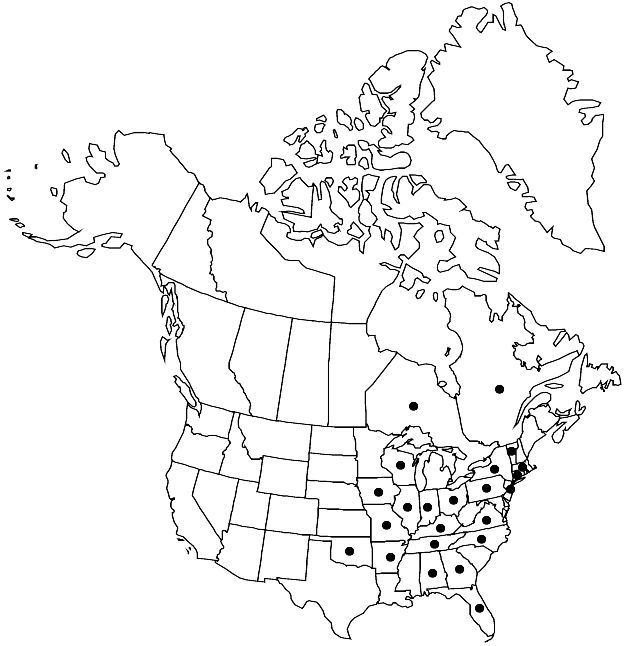Difference between revisions of "Cyrto-hypnum pygmaeum"
Contr. Univ. Michigan Herb. 17: 67. 1990.
FNA>Volume Importer |
imported>Volume Importer |
||
| (6 intermediate revisions by 2 users not shown) | |||
| Line 7: | Line 7: | ||
|year=1990 | |year=1990 | ||
}} | }} | ||
| − | |basionyms={{Treatment/ID/ | + | |basionyms={{Treatment/ID/Basionym |
|name=Thuidium pygmaeum | |name=Thuidium pygmaeum | ||
|authority=Schimper | |authority=Schimper | ||
| + | |rank=species | ||
| + | |publication_title=in P. Bruch and W. P. Schimper, Bryol. Europ. | ||
| + | |publication_place=5: 162. 1852 | ||
}} | }} | ||
|synonyms= | |synonyms= | ||
| Line 26: | Line 29: | ||
|elevation=low to moderate elevations | |elevation=low to moderate elevations | ||
|distribution=Ont.;Que.;Ala.;Ark.;Conn.;Fla.;Ga.;Ill.;Ind.;Iowa;Ky.;Mass.;Mo.;N.J.;N.Y.;N.C.;Ohio;Okla.;Pa.;Tenn.;Vt.;Va.;Wis.;Asia (China;Japan;Korea). | |distribution=Ont.;Que.;Ala.;Ark.;Conn.;Fla.;Ga.;Ill.;Ind.;Iowa;Ky.;Mass.;Mo.;N.J.;N.Y.;N.C.;Ohio;Okla.;Pa.;Tenn.;Vt.;Va.;Wis.;Asia (China;Japan;Korea). | ||
| − | |discussion=<p>Cyrto-hypnum pygmaeum is the smallest species of the genus in the flora area; the diminutive stature coupled with papillose stems and branches is distinctive. The species is most likely confused with Heterocladium macounii (Pterigynandraceae), which also has multipapillose laminal cells and papillose stems and branches. However, H. macounii is larger and has a costa ending near or before mid leaf and is without paraphyllia; pseudoparaphyllia are present, but these have pointed apical cells, not truncate as are the paraphyllia cells of C. pygmaeum.</p> | + | |discussion=<p><i>Cyrto-hypnum pygmaeum</i> is the smallest species of the genus in the flora area; the diminutive stature coupled with papillose stems and branches is distinctive. The species is most likely confused with <i>Heterocladium macounii</i> (Pterigynandraceae), which also has multipapillose laminal cells and papillose stems and branches. However, <i>H. macounii</i> is larger and has a costa ending near or before mid leaf and is without paraphyllia; pseudoparaphyllia are present, but these have pointed apical cells, not truncate as are the paraphyllia cells of <i>C. pygmaeum</i>.</p> |
|tables= | |tables= | ||
|references= | |references= | ||
| Line 35: | Line 38: | ||
-->{{#Taxon: | -->{{#Taxon: | ||
name=Cyrto-hypnum pygmaeum | name=Cyrto-hypnum pygmaeum | ||
| − | |||
|authority=(Schimper) W. R. Buck & H. A. Crum | |authority=(Schimper) W. R. Buck & H. A. Crum | ||
|rank=species | |rank=species | ||
| Line 50: | Line 52: | ||
|publication year=1990 | |publication year=1990 | ||
|special status= | |special status= | ||
| − | |source xml=https:// | + | |source xml=https://bitbucket.org/aafc-mbb/fna-data-curation/src/2e0870ddd59836b60bcf96646a41e87ea5a5943a/coarse_grained_fna_xml/V28/V28_591.xml |
|genus=Cyrto-hypnum | |genus=Cyrto-hypnum | ||
|species=Cyrto-hypnum pygmaeum | |species=Cyrto-hypnum pygmaeum | ||
Latest revision as of 22:36, 5 November 2020
Stems 2-pinnate, stems and branches papillose; paraphyllia (1–)2–4(–5) cells in length, cells 1:1, strongly papillose. Stem leaves slightly incurved when dry, ovate-triangular, 0.2–0.4 mm; apex acuminate; costa 3/4 leaf length. Branch leaves erect-incurved when dry, 0.2–0.3 mm on primary branches, 0.2 mm on secondary branches; apex acute to short-acuminate; costa 1/2–3/5 leaf length, straight, not covered with cells apically. Perichaetial leaves with margins subentire proximally, serrulate distally. Seta smooth. Capsule with endostome cilia in pairs.
Phenology: Capsules mature summer (Jul–Sep).
Habitat: Moist woods, moist rock, limestone, sandstone, quartzite
Elevation: low to moderate elevations
Distribution

Ont., Que., Ala., Ark., Conn., Fla., Ga., Ill., Ind., Iowa, Ky., Mass., Mo., N.J., N.Y., N.C., Ohio, Okla., Pa., Tenn., Vt., Va., Wis., Asia (China, Japan, Korea).
Discussion
Cyrto-hypnum pygmaeum is the smallest species of the genus in the flora area; the diminutive stature coupled with papillose stems and branches is distinctive. The species is most likely confused with Heterocladium macounii (Pterigynandraceae), which also has multipapillose laminal cells and papillose stems and branches. However, H. macounii is larger and has a costa ending near or before mid leaf and is without paraphyllia; pseudoparaphyllia are present, but these have pointed apical cells, not truncate as are the paraphyllia cells of C. pygmaeum.
Selected References
None.